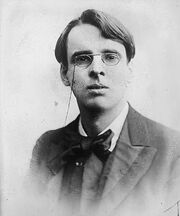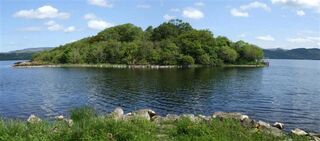
William Butler Yeats in 1920. Courtesy Wikimedia Commons.
The "Lake Isle of Innisfree" is a poem written by William Butler Yeats in 1888.
The Lake Isle of Innisfree[]

The Lake Isle of Innisfree. Photo by Kenneth Allen. Licensed under Creative Commons, courtesy Geograph.org.

The Lake Isle of Innisfree read by Yeats
I will arise and go now, and go to Innisfree,
And a small cabin build there, of clay and wattles made:
Nine bean-rows will I have there, a hive for the honeybee,
And live alone in the bee-loud glade.
And I shall have some peace there, for peace comes dropping slow,
Dropping from the veils of the morning to where the cricket sings;
There midnight's all a glimmer, and noon a purple glow,
And evening full of the linnet's wings.
I will arise and go now, for always night and day
I hear lake water lapping with low sounds by the shore;
While I stand on the roadway, or on the pavements grey,
I hear it in the deep heart's core.
History[]
The poem was originally published in the National Observer in 1890, and reprinted in The Countess Kathleen, and Various legends and lyrics in 1892. One of Yeats's earlier poems, "The Lake Isle of Innisfree" was an attempt to create a form of poetry that was Irish in origin rather than one that adhered to the standards set by English poets and critics.[1] The poem, unlike many others from the era, does not contain direct references to mysticism and the occult, yet it received critical success in the United Kingdom as well as in France.[2]
The poem is not to be confused with the song, "The Isle of Innisfree". The two works are completely different and original in their own right but are very often mistakenly thought to be the same. "The Isle of Innisfree" is a song that was written in 1949, with words and music by Irish songwriter Dick Farrelly. The melody was used as the main theme of the film "The Quiet Man".
Background[]
When Yeats was a child, his father had read to him from Walden by Henry David Thoreau, and Yeats described his inspiration for the poem by saying that while he was a teenager, he wished to imitate Thoreau by living on Innisfree, an uninhabited island in Lough Gill.[3] He suggests that when he was living in London, he would walk down Fleet Street and long for the seclusion of a pastoral setting such as the isle. The sound of water coming from a fountain in a shop window reminded Yeats of the lake that he had previously seen, and it is this inspiration that Yeats credits for the creation of the poem.[4]
In his youth, Yeats would visit the land at Lough Gill at night, often accompanied by his cousin Henry Middleton. On one occasion, they went out onto the lake at night on a yacht to observe birds and to listen to stories by the crew. The trips that Yeats took from the streets of Sligo to the remote areas around the lake set up for him the contrasting images of the city and nature that appear in the poem's text.[3]
Analysis[]
The poem is a 12-line poem divided into three quatrains and an example of Yeats’s earlier lyric poems.
Throughout the three short quatrains the poem explores the speaker’s longing for the peace and tranquility of Innisfree while residing in an urban setting. The speaker in this poem yearns to return to the island of Innisfree because of the peace and quiet it affords. He can escape the noise of the city and be lulled by the "lake water lapping with low sounds by the shore." On this small island, he can return to nature by growing beans and having bee hives, by enjoying the "purple glow" of noon, the sounds of birds' wings, and, of course, the bees. He can even build a cabin and stay on the island much as Thoreau lived on Walden Pond.
During his lifetime it was — to his annoyance — 1 of his most popular poems and on 1 occasion was recited (or sung) in his honor by 2,000 (or 10,000; accounts vary) boy scouts.[5]
See also[]
References[]
- ↑ Kenner, Hugh. "The Conquest of English". A Colder Eye.Johns Hopkins University Press 1983 p.51
- ↑ Jochum,Klaus Peter. "The Reception of W.B. Yeats in France". The Reception of W.B. Yeats in Eurpoe. Continuum 2006 p.33
- ↑ 3.0 3.1 Jeffares, Alexander Norman. W.B. Yeats: Man and Poet. Macmillan 1962 pp21Template:Endash23
- ↑ Yeats, William Butler. Autobiographies. London: Macmillan 1955, p.153
- ↑ R. F Foster: W. B. Yeats, A Life. Vol. 1. The apprentice Mage
External links[]
- Audio / video
- Etc.
| This page uses Creative Commons Licensed content from Wikipedia. (view article). (view authors). |